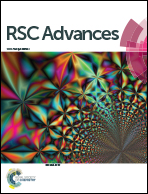Efficient conversion of ethanol to 1-butanol and C5–C9 alcohols over calcium carbide†
Abstract
Production of 1-butanol or alcohols with 4–9 carbon atoms (C4–C9 alcohols) from widely available bio-ethanol has attracted much interest in recent years in academia and industry of renewable chemicals and liquid fuels. This work discloses for the first time that calcium carbide (CaC2) has a superior catalytic activity in condensation of ethanol to C4–C9 alcohols at 275–300 °C. The 1-butanol yield reached up to 24.5% with ethanol conversion of 62.4% at the optimized conditions. The by-products are mainly alcohols with 5–9 carbons besides 2-butanol, and the total yield of all the alcohols reached up to 56.3%. The reaction route was investigated through controlled experiments and quantitative analysis of the products. Results indicated that two reaction routes, aldol-condensation and self-condensation, took place simultaneously. The aldol-condensation route involves coupling of ethanol with acetaldehyde (formed from ethanol dehydrogenation) to form 2-butenol, which is subsequently hydrogenated to 1-butanol. The alkynyl moiety in CaC2 plays an important role in the catalytic pathways of both routes and affords the good activity of CaC2. CaC2 is converted to acetylene [C2H2] and calcium hydroxide [Ca(OH)2] simultaneously by the H2O that was generated from the condensation of alcohols.



 Please wait while we load your content...
Please wait while we load your content...